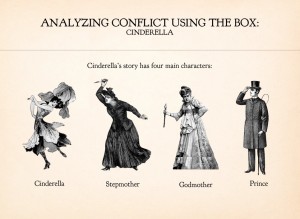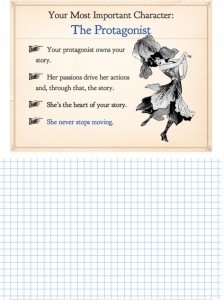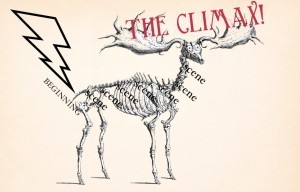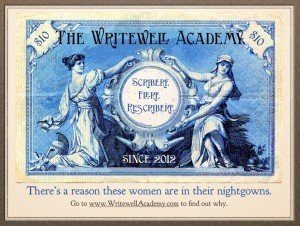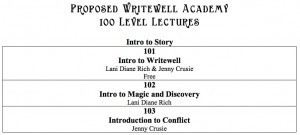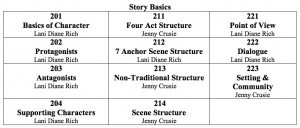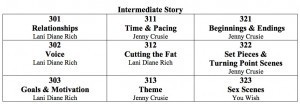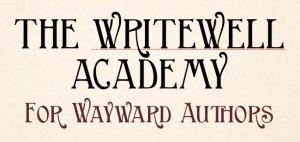Jennifer Crusie's Blog, page 312
April 3, 2012
Words, Pictures, Music
We've been working on the Writewell stuff for awhile now, putting the pieces together. We need a script, we need a slide show outline, we need pictures. What I'm finding as I put these lessons together is that the three things interact with each other and change each other. It's an entirely new approach to writing for me, and I'm finding that for non-fiction at least, it seems to be remarkably effective at getting content organized and presented.
I start with the slide show which is pretty much a visual outline of what I want to say, words on a screen. As it occurs to me, I add images that I hope will make the concepts stick. Then the images change the content because they've clarified the idea. Then I write the script to go with the slides, and as I write the slides expand to follow trains of thought, and the images shift to illustrate what I have to say. And then the images change the script . . . I'm so far into the 4 Act Structure slide presentation that I don't even know if it makes sense, but I know it's much better than it was before I worked with written words, pictures, and sound.
I've always known that pictures helped in fiction writing because I made collages that were vital to the books. And I knew that sound made a difference because reading my stuff out loud as a final edit is really effective. (Actually reading it on paper is completely different from reading it on screen, too.) But I don't think I've ever put all three together like this. it's really exciting. Add in that Lani is teaching me to manipulate the slide show so that it matches up with the recording, and it's been an illuminating two weeks.
I'm trying to think how I can do this more directly with fiction, and I'm not seeing a way. But I think when I finally do my non-fiction books, I'm going this way, lots of graphics and sidebars, presenting the information as many ways as possible.
Anybody out there have experience with this? And does my plan sound like a good thing in a book? (It's a good thing in a video slide show for sure.)

March 31, 2012
The Argh Writing Craft Reading List
And here it is, the suggested reading on writing in alphabetical order by author, culled from the comments of the previous post. My faves are Seger, Burroway, McKee, and Mernit if you're writing romantic comedy. And when I go to supernatural/fairy tale stuff, I hit Vogler again. I also remember loving Block's Telling Lies for Fun and Profit and reading Bickham over and over. The Browne/King book is a great editing book. Michael Hauge's seminars taught me so much, so I know his book is good. Don Maass and Deb Dixon, too. But many of these are new to me (and some aren't but I didn't like them, so I'm just keeping my mouth shut on those), so I have some new research to do. In the meantime, here's your list, Argh.
Bell, James Scott, The Art of War for Writers
—, Conflict and Suspense
—, Plot and Structure
Bell, Susan, The Artful Edit
Bickham, Jack. The 38 Most Common Fiction Writing Mistakes (and How to Avoid Them)
—, Scene and Structure
—, Writing and Selling Your Novel
Block, Lawrence, On Character
—, Telling Lies for Fun and Profit
Bradbury, Ray, Zen in the Art of Writing: Essays on Creativity
Bright, Susie, How to Tell a Dirty Story
Brooks, Terry, Sometimes the Magic Works: Lessons from a Writing Life
Browne, Renni, and Dave King, Self-Editing for Fiction Writers
Burroway, Janet, Writing Fiction
Card, Orson Scott, Characters and Viewpoint
Dixon, Deb, Goal, Motivation, Conflict
Evanovich, Janet, How I Write
Frey, James H., How to Write a Damn Good Novel
Gardner, John, The Art of Fiction
George, Elizabeth, Write Away
Goldberg, Natalie, Writing Down the Bones
Hauge, Michael, Selling Your Story in Sixty Seconds
—,Writing Screenplays That Sell
Hayden, G. Miki, Writing the Mystery
Hood, Ann, Creating Character Emotions
Horton, Andrew, Writing the Character Centered Screenplay
King, Stephen, On Writing
Klein, Cheryl B., Second Sight
Knost, Michael, ed, Writer's Workshop of Horror
LeGuin, Ursula, Steering the Craft
Lukeman, Noah, The First Five Pages
Lyon, Elizabeth, Manuscript Makeover
Maass, Donald, Writing the Breakout Novel
Masello, Robert, Robert's Rules of Writing
Mayer, Bob, The Novel Writer's Toolkit
McClanahan, Rebecca, Word Painting
McKee, Robert, Story
Mernit, Billy, Writing the Romantic Comedy
Peck, Robert Newton, Fiction is Folks
Pressfield, Stephen, The War of Art
Rasley, Alicia, The Power of Point of View
—. The Story Within Plot Guide for Novelists
Linda Seger, Making a Good Script Great
Snyder, Blake, Save the Cat
—, Save the Cat Goes to the Movies
—, Save the Cat Strikes Back
Sokoloff, Alexandra, Screenwriting Tricks for Authors
—, Writing Love: Screenwriting Tricks for Authors II
Stein, Sol, How to Grow a Novel
—, Solutions for Writers
—, Stein on Writing
Swain, Dwight, Techniques of the Selling Writer
Truby, John, Elements of Story
Ueland, Brenda, If You Want To Write
Vogler, Chris, The Writer's Journey
Watts, Nigel, Write a Novel and Get It Published
Weiland, K. M., Outlining Your Novel: Map Your Way to Success
Wheat, Carolyn, How to Write Killer Fiction
Whitcomb, Laura, Novel Shortcuts
Williams, Joseph, Style: Lessons in Clarity and Grace
Williams, Stanley D, The Moral Premise: Harnessing Virtue and Vice for Box Office Success
Wood, Monica, Pocket Muse
The Weekend Novelist, Story Structure Architect, Emotional Structure (look up author)

March 27, 2012
Books on Writing Books
I need to make a short list of good writing books. Left to me, it will be extremely short: Seger, McKee, and Mernit. I'm talking about craft books not the Bird-by-Bird kind of books (which are also extremely valuable but not my focus at the moment). If you've got a minute, tell me what craft books have made a difference to your writing.

March 25, 2012
Writewell, the Last Post About It (for awhile) I Swear
It's been really interesting working on these first courses. The 101 lecture is just an introduction to Writewell itself, but I've finished the slides and notes for 103 (Conflict), and I'll finish 211 (4 Act Structure) today, and I've got a good start on 221 (Scene). Some of the time was spent learning the very basic skills I needed for illustration and animation (and I mean basic), but most of it was taking all the stuff I knew about the one particular topic and synthesizing it down into three support points and then making them as clear as possible. I've done the 103 lecture at least a dozen times, trying to find a balance between abstract information ("You need conflict") and application ("Here's an example of conflict") that can then be extrapolated into exercises so people can use their own stories as examples of the concepts. Trying to hit the people who learn by watching, the people who learn by listening, the people who learn by hands-on doing, and the people who learn by reading is challenging. I've pretty much decided that the people who like to learn by reading paragraphs are going to be the ones short-changed here because I don't want to write a book for each lecture. I'm thinking that the video lecture with voiceover, the separate audio (which will have to make some sense on its own even though it'll be referring to the slides), and the support materials for hands-on learning (which for me will be a notebook* for ideas as you watch the slide show and a workbook to use for your own story) will cover it.
What always amazes me is how, no matter what I teach, getting ready for a class affects the story I'm working on. It's impossible to think about these concepts without applying them to the story in my head, and I've had any number of lightbulb moments since I started this. They're such basic concepts until you use them as lenses to see your stories through, and then they're like one of those prism kaleidoscopes: what they mean depends on what you're looking at. If I can make that happen for other people, that'll be a good, good thing.
We have hit a couple of small snags, one of which is that there is no automatic download feature, so evidently after Paypal gets the cash, it sends us a notification and then we send the lecture on. Since we're all on the computer pretty much all the time, there shouldn't be much of a lag time, but it isn't as swiftly automated as I'd have liked. On the other hand, it'll work. I can't imagine it ever taking longer than twenty-four hours for us to see an e-mail, so that's probably what we'll promise.
Still a lot has been fun. Getting the clip art together for the first lectures has been a blast. Once I decided that the only aesthetic guideline I needed was black and white drawings, I've been mixing and matching illustration styles and periods with abandon. My Virgo heart clutches sometimes when I see how much abandon, but since I'll probably be using the same protagonist and antagonist clips throughout all my lectures, and since I love them, I'm stifling my inner iron-out-all-the-wrinkles and going for it. I'm counting on people liking dorky illustration and animation, but I also know that everything I'm putting in there really does make the concepts clearer, so I think I'm safe. Kinda. Maybe.
Also, we're working out a way to have Writewell forums within the Cherry Forums structure, and they'll launch when the lectures go live and the Cherry revamp is complete. Lots of new stuff here, but then it's spring. New growth! Or something much like it.
We may not make the April 1 launch date (that's only five days away ARGH), but we'll definitely be up and running soon, and it'll be a much, much better thing because of all of you. I am grateful as always to Argh Nation. You have the patiences of saints and the revision skills of surgeons. Thank you all so much.
Edited to add: This is sort of what a sample notebook page will look like (much better margins): One of the main slides (not all of the slides) with a grid underneath for taking notes (because I like quad-ruled better than regular ruled paper when I take notes):

March 22, 2012
Writewell, the Course Description
So in the interests of keeping things simple so potential buyers don't have to wade through a lot of stuff to find info, I've pared the content for my lecture pages down to a minimum. What I need to know is, does this give enough info about the course?
Lecture 103: Introduction to Conflict
Conflict is the fuel of story . . .
and this lecture tells you how to use it. The lesson can also help in writing a first draft as long as you're still focusing on your story and not on craft, but it's probably most useful for analyzing a finished draft.
The 103 Lecture is divided into four parts:
1. The Definition of Conflict
2. The Major Players: Protagonist and Antagonist
3. Analyzing Conflict in Story
4. Revising for a Conflict Lock
The Lecture Package has five parts:
1. The Slideshow Lecture with voiceover
2. The Audio of the voiceover alone.
3. The 103 Notebook (thumbnails of the slides with quad-ruled spaces for taking notes)
4. The 103 Workbook (exercises to analyze your story in progress with the concepts of the lecture)
5. Certificate of Completion.
How to Use the Lecture Packet Suggested Plan of Study:
1. Push the Paypal button and download your packet. [I'll get the exact instructions from Alastair later.]
2. Watch the video without taking notes to become familiar with the basics of conflict as an introduction to the material.
3. Watch the video again, this time using the Notebook to take notes of the important points.
4. Using the Workbook, analyze your story-in-progress to understand the conflict and revise for a conflict lock.
5. Fill out the certificate and tape it to your wall. You worked hard; you deserve it.
Or
Lecture 211: The Four Act Structure
Structure is the spine of your story . . .
It really doesn't matter what structure you use as long as you have a structure, but the classic linear plot is the most common in storytelling. The four-act approach to linear storytelling is adapted from Aristotle and screenplay structure, so it's both classic and modern, referencing the basics of structure for thousands of years and the way most people get their story today.
Pre-requisite: Lecture 211: The Four Act Structure
The 211 Lecture is divided into four parts:
1. The Definition of Story Structure
2. The Importance of Turning Point Scenes
3. The Use of Acts in Building Story
4. The Crucial Role of the Climax
The Lecture Package has five parts:
1. The Slideshow Lecture with voiceover
2. The Audio of the voiceover alone.
3. The 211 Notebook (thumbnails of the slides with quad-ruled spaces for taking notes)
4. The 211 Workbook (exercises to analyze your story in progress with the concepts of the lecture)
5. Certificate of Completion.
How to Use the Lecture Packet:
1. Push the Paypal button and download your packet.
2. Watch the video without taking notes to become familiar with the basics of conflict as an introduction to the material.
3. Watch the video again, this time using the Notebook to take notes of the important points.
4. Using the Workbook, analyze your story-in-progress to understand the conflict and revise for a conflict lock.
5. Fill out the certificate and tape it to your wall. You worked hard; you deserve it.
Does that tell you enough? Is there too much information there? Help.

March 19, 2012
Writewell: Ever Evolving
We're still in let's-put-on-a-show-in-the-barn mode here, so all the feedback is great. The ad was half a joke–we're kind of liking a Victorian vibe for the design as a whole but the rest was in-joke snark–but all the comments were right to the point and very helpful. Meanwhile, behind the curtain, I've been trying to figure out how to make my lectures worth $10. That still seems like a lot of money to me for a forty-five minute slide show (with the audio track also available alone), so the workbook is going to have to really helpful. I do think the content is excellent, it's just forty-five minutes is not much time, and if you try to give people too much to learn at once, nobody learns anything. So synthesizing content down, making it clear, and then figuring out how to apply it in workbook pages . . . that's what I'm working on now. I did start working in Photoshop finally and I'm experimenting with animation in Keynote because a lot of people remember visuals better than they do words, and I'd forgotten how much fun it is to learn a new skill. And I'm looking for vintage images now that I can use to make concepts clear. Like the ad yesterday, a lot of it is just me having fun with new toys, but I did an animation to demonstrate the idea of structure. and I kind of want the final slide of the sequence on a T-shirt. Not sure it makes sense without the narration, but here's Morrie, the Plot Moose:
I may have been a junior high teacher for too long. I'm big on colorful and moving.
So here's my question for the day. These lectures are going to be a filmed slideshow with narration. A basic PowerPoint presentation (except we use Keynote, of course) with voiceover that plays like a movie. In your experience with this kind of presentation (yes, I know 95% of slide presentations suck, we're trying for the other 5%), what works? What doesn't? What would you like to see? What should be avoided at all costs?
Because otherwise, you're gonna get a lot of stuff like Morrie.

March 18, 2012
Writewell, The PR Campaign
So we've been working on Writewell along with our books. Lani has the kinks worked out of the audio process. I'm learning Photoshop Element which is long overdue. We've got the first three lectures written, although not produced. We're getting there. In the off moments, I've been thinking about marketing. Not too hard, but marketing. So I'm wondering, what would make you as a writing student (if you're not a writing student, pretend you are for a moment) go check out Writewell, assuming you'd never heard of Lani, me, Storywonk or Argh? (Amazingly, people like this exist.)
I did do one teaser ad, but it was more because I was having such a good time learning Photoshop than it was because I thought it would be effective or had any idea what we would do with it. The website is not up yet, but . . . (Click to see it larger.)
Yeah, that probably won't work. How should we market this thing?

March 15, 2012
The Writewell Academy, Part Three
First thank you so much for all the feedback. It's been tremendously helpful. I feel better than ever about the $10 per lecture, but it's good to question these things. Lani and I are working on the first three right now so we can get a feel for how this works while establishing the format and website and all that stuff. We're keeping it simple, but it still has to be done in a way we're both satisfied with, and since we're both perfectionists, that's gonna take some days. I'll close the comments on the other thread and move them to this one so we can still keep talking about it, but the response to the last two posts have clarified so much that we can really move forward now. And thank you so much. The Argh People never fail.

March 13, 2012
The Writewell Academy, Part Two
Lani and I had lunch and talked about the Writewell Academy idea in more detail, then read the feedback we've been getting and talked again tonight, and here's where we are tentatively.
The 100 level lectures would go up first:
The first one describes the overall approach of the lecture series and gives people a chance to experience the format we're using. It's free so that people can find out what they're getting into without spending money.
The second one is the only lecture that we recommend before you have your story draft done. It's about finding your story in the mass of ideas, different ways of accessing the girls in the basement, etc.
The third one is about the essence of story: protagonist/goal/antagonist/goal/conflict/crucible.
You should know the stuff in the 100 level courses before you try 200 level courses:
The 200 level is a closer look at the different basic components of story. The first column is character, the second is structure (two different approaches to classic linear structure) and scene, and the third is everything else. (I just checked the third column and the numbering is all off there because we were moving stuff around. Ignore the course numbers in the third column. They are wrong.)
The 300 level is stuff from the 200 level taken to a more abstract and in-depth level. It's a good idea to take whatever 200 level course comes before the the 300 level you want because we're going to assume you know that stuff, unless you already know that stuff, of course.
Then there's the 400 level, but it's going to take a year to write and record these, so later for that.
Tuition: All classes are $10. We're not going to get fancy with the pricing. You want a lecture, that'll be ten bucks, thank you. Hit that PayPal button.
Forums: None to begin with. We're both swamped as it is, and while we're really enthusiastic about this project, the enthusiasm is limited to the lectures at the moment.
Certificates: Sure. They'll be fabulous certificates, too. Lani suggests a certificate for each section, so a 100 level certificate, a 200 level character certificate, a 200 level structure certificate, etc.
Merchandise: Clearly there's an interest in merchandising, so sure you can have V-neck T-shirts. It's going to take some research because we want good quality stuff–I like Skreened for t-shirts but that's all they sell, so maybe not–but we're designing the website as I type this, so merchandise design can go right along with that.
Okay, opinions, questions, complaints, suggestions?

The Writewell Academy for Wayward Authors
Lani and I have been talking about a new project, The Writewell Academy for Wayward Authors, a collection of hour-long, downloadable lectures in narrated slideshow format that would include a short PDF workbook with each class ("workbook" does not mean "textbook," it would be an outline for taking notes). We have a tentative list of courses and a tentative idea of what to charge, but the key word is "tentative."
The Academy coursework would be divided into different levels. One hundred level courses would be the basics: a very general overview of story (that one would be free), introduction to discovery, and introduction to story core elements. Two hundred level courses would be about specific aspects of character (protagonist, antagonist, supporting characters, etc.) and plot (four act structure, 7 anchor scenes, scene, etc. Three hundred level courses would be about more advanced concepts–theme, metaphor and symbol, etc. And four hundred level would be application of all those things in different ways, such as analysis of a single story using all of the concept, Lani taking apart one of her books and me taking apart one of mine. Or something like that. We're still figuring it out, which is why I'd like your input, since you've seen most of these concepts float past you here on Argh in the past years.
So here's what I want to know:
What lecture topics do you think should be covered? (Remember, the lectures are an hour, so they have to be very focused. "Plot" is not an option.)
How much is it fair to charge? (We're both behind on our books and we'd like to pay the mortgage, but we're not into ripping off writers, either.)
Oh, and I designed T-shirts because every school has T-shirts. I was inspired by my fave college T-shirt of all time from when I taught at Antioch: "Antioch College: No Football Team Since 1929." (They did used to play naked frisbee on campus, though.)
The front would be something like:
With several different backs:
So what do you think?


